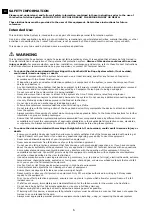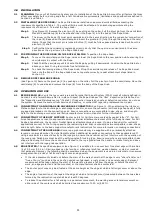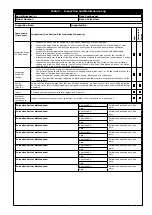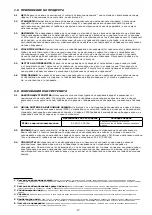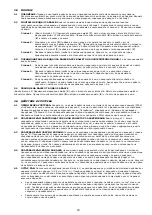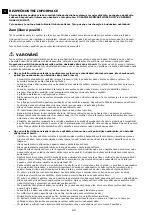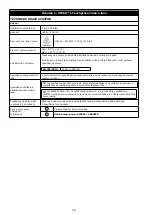
9
1.0 PRODUCT APPLICATION
1.1 PURPOSE:
Rope Grabs are designed to be a component in a Fall Arrest
1
or Fall Restraint
2
system. See Figure 2 for
system applications.
1.2 STANDARDS:
Your Rope Grab conforms to the national or regional standard(s) identified on the front cover of these
instructions. If this product is resold outside the original country of destination, the re-seller must provide these
instructions in the language of the country in which the product will be used.
1.3 TRAINING:
This equipment must be installed and used by persons trained in its correct application. This manual
is to be used as part of an employee training program as required by CE, and/or regional regulations. It is the
responsibility of the users and installers of this equipment to ensure they are familiar with these instructions, trained
in the correct care and use of this equipment, and are aware of the operating characteristics, application limitations,
and consequences of improper use of this equipment.
1.4 RESCUE PLAN:
When using this equipment and connecting subsystem(s), the employer must have a rescue plan and
the means at hand to implement and communicate that plan to users, authorized persons
3
, and rescuers
4
. A trained,
on-site rescue team is recommended. Team members should be provided with the equipment and techniques to
perform a successful rescue. Training should be provided on a periodic basis to ensure rescuer proficiency.
1.5 INSPECTION FREQUENCY:
The Rope Grab shall be inspected by the user before each use and, additionally, by a
Competent Person
5
other than the user at intervals of no longer than one year.
6
Inspection procedures are described
in the
“Inspection and Maintenance Log”
. Results of each Competent Person inspection should be recorded on copies
of the
“Inspection and Maintenance Log”
.
1.6 AFTER A FALL:
If the Rope Grab or its attaching lanyard or vertical lifeline are subjected to the forces of arresting a
fall, it must be removed from service immediately and destroyed. Do
not
attempt maintenance or repair.
2.0 SYSTEM REQUIREMENTS
2.1 ANCHORAGE:
Anchorage structure requirements vary with the system application. The structure to which the Rope
Grab and its vertical lifeline are connected or mounted must meet the Anchorage Specifications defined in Table 1.
2.2 PERSONAL FALL ARREST SYSTEM:
Figure 2 illustrates the application of this Rope Grab. Personal Fall Arrest
Systems (PFAS) used with the system must meet applicable Fall Protection standards, codes, and requirements. The
PFAS must incorporate a Full Body Harness and limit Arresting Force to the following values:
Maximum Arresting Force
Free Fall
PFAS with Energy-Absorbing Lanyard
6.0 kN (1,350 lbs)
Refer to the instruction(s) included
with your Lanyard for Free Fall
limitations.
2.3 LANYARDS:
Refer to the instruction(s) included with your Lanyard for limitations specific to Lanyard use. See Table 1
for limitations of Lanyard use specific to this Rope Grab. Do not lengthen Lanyards for use with this Rope Grab without
consulting 3M. All Lanyards used (if applicable) must have a minimum breaking strength of 22 kN (5,000 lbs).
2.4 HAZARDS:
Use of this equipment in areas with environmental hazards may require additional precautions to prevent
injury to the user or damage to the equipment. Hazards may include, but are not limited to: heat, chemicals,
corrosive environments, high voltage power lines, explosive or toxic gases, moving machinery, sharp edges, or
overhead materials that may fall and contact the user or Personal Fall Arrest System.
2.5 FALL CLEARANCE:
Figure 3 illustrates the components of a Fall Arrest. There must be sufficient Fall Clearance (FC)
to arrest a fall before the user strikes the ground or other obstruction. Clearance is affected by a number of factors
including: Anchorage Location, (A) Lanyard Length, (B) Lanyard Deceleration Distance, (C) Harness Stretch, D-Ring/
Connector Length and Settling, (D) Rope Grab Lock-Up Distance, (E) Vertical Lifeline Length and Stretch, and (SF)
Safety Factor. Lanyard Length and Lanyard Deceleration Distance will vary with the Lanyard model.
Refer to Table 1 for details on Fall Clearance requirements. Figure 4 illustrates how positioning of the Rope Grab
affects the required Fall Clearance. Figure 5 gives the specific Fall Clearance value that is necessary, based on
the exact positioning of the Rope Grab. See Figure 4 and Figure 5 to determine Fall Clearance requirements. Fall
Clearance values include a 1.0 m Safety Factor.
To determine required Fall Clearance (Figure 4 and Figure 5):
Measure the distance (G) between the anchor point and the installed Rope Grab. Use this value and refer to Figure 5
to determine the required Fall Clearance (FC).
2.6 SWING FALLS:
Swing Falls occur when the anchorage point is not directly above the point where a fall occurs (see
Figure 6). The force of striking an object in a swing fall may cause serious injury or death. Minimize swing falls by
working as directly below the anchorage point as possible. Do not permit a swing fall if injury could occur. Swing falls
will significantly increase the clearance required when a Self-Retracting Device or other variable length connecting
subsystem is used.
1 Fall Arrest System:
A collection of Fall Protection Equipment configured to arrest a free fall. Protects the user in the event of a fall. Free fall is permitted
up to the limits allowed by the connecting device (for use with an Energy-Absorbing Lanyard only).
2 Restraint System:
A collection of Fall Protection Equipment configured to prevent the person’s center of gravity from reaching a fall hazard. Prevents the
user from reaching a hazard. No vertical free fall is permitted.
3 Authorized Person:
A person assigned by the employer to perform duties at a location where the person will be exposed to a fall hazard.
4 Rescuer:
Person or persons other than the rescue subject acting to perform an assisted rescue by operation of a rescue system.
5 Competent Person:
One who is capable of identifying existing and predictable hazards in the surroundings or working conditions which are unsanitary,
hazardous, or dangerous to employees, and who has authorization to take prompt corrective measures to eliminate them.
6 Inspection Frequency:
Extreme working conditions (harsh environments, prolonged use, etc.) may require increasing the frequency of Competent
Person inspections.
Summary of Contents for AC40 Series
Page 14: ...14 3 3M 3M 3 Arc Flash Hot Works 3 3 Full Body Harness BG...
Page 21: ...2 A 5 1 2 3 4 5 6 1 1 2 3 4 1 12...
Page 46: ...46 3 3 3 3 Top Drive Arc Flash Hot Works 3 3 EL...
Page 50: ...50 2 5 3 FC D SF 1 4 5 4 5 4 5 5 FC 2 6 6 2 7 3 3 2 8 3 D 20 kN 4 500 7 2 9 3 8 D C D F G...
Page 53: ...2 5 1 2 3 4 5 6 1 1 2 3 4 1 12...
Page 86: ...86 Vertical Lifeline Vertical Lifeline 3M 3M lifeline lifeline 3M 3M 3M HE...
Page 90: ...90 2 9 8 3M D roll out...
Page 93: ...2 5 1 1 1 12...
Page 126: ...126 3M 3M 3M 3M Arc Flash Hot Works 3M 3M KA...
Page 133: ...2 5 1 1 r 12...
Page 238: ...238 3M 3M 3M 3M 3M 3M UA...
Page 242: ...242 4 5 G 5 2 6 6 2 7 3M 3 2 8 3 D 20 2041 7 A B C 2 9 3 8 A D B C D E F G...
Page 245: ...2 5 1 2 3 4 5 6 1 1 2 3 4 1 12...
Page 256: ......
Page 257: ......
Page 258: ......
Page 259: ......






